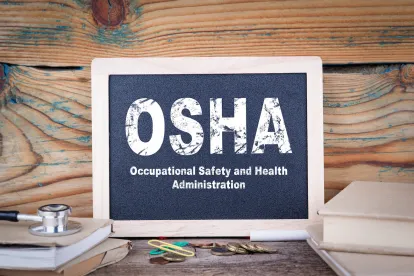Robert F. Kennedy, Jr. observed that democracy is messy and hard.
The serial legal battle over COVID-19 and what the federal government can and should make employers do about it illustrates the point.
Late on Friday, December 17, 2021, a three-judge panel of the U.S. Court of Appeals for the Sixth Circuit issued an order that affects most U.S. employers with 100 or more employees.
In a 2-1 bipartisan decision, the Court dissolved the suspension (or "stay") of the U.S. Department of Labor's OSHA "emergency temporary standard" ("ETS"), which had been in place since November 6. The ETS, thus revived, requires covered employers with 100 or more employees to require their employees to (1) be fully vaccinated against COVID-19 or (2) wear approved protective face coverings in the workplace and take weekly COVID-19-tests at employees' expense.
The Occupational Safety and Health Administration of the Department of Labor ("DOL"), when the ETS came out on November 5, 2021, gave employers little time to react: it imposed compliance deadlines of December 5, 2021, and January 4, 2022 – the first of which is now academic and the second of which is a mere 15 holiday-packed days away.
The DOL, according to a news release issued on December 18, wisely recognizes the "uncertainty created by the stay" of the ETS and has therefore elected to exercise "enforcement discretion with respect to the [ETS's] compliance dates".
Its discretion, however, goes only so far. In what – in a less urgent context – might indicate a sense of humor, the DOL says that "[t]o provide employers with sufficient time to come into compliance, OSHA will not issue citations for noncompliance with any requirements of the ETS before January 10 and will not issue citations for noncompliance with the standard’s testing requirements before February 9, so long as an employer" – in the judgment of the DOL – "is exercising reasonable, good faith efforts to come into compliance with the standard."
OSHA offers the assurance that it "will work closely with the regulated community to provide compliance assistance”, but it, and covered employers, should be prepared to work fast.
What Should Large Employers Do Now?
For a summary of who is covered and the corresponding obligations, see the article that we wrote on November 5, 2021. The ETS is, for the moment at least, back in full force and effect, although the deadlines by which affected employers must comply with it have obviously been postponed (albeit not by much).
Vigilant covered employers had therefore better be prepared to:
-
Adopt a COVID-19 policy that, in pertinent part, requires covered employees to obtain their second Pfizer or Moderna shot or a single dose of the Johnson and Johnson shot by January 10, 2022. To assist our clients with this, we have developed OSHA-compliant policy templates that can be tailored to a client's specific needs.
-
Determine employees' vaccination status and develop a roster of which employees have been vaccinated, which employees have not been, and which employees cannot be tested for 90 days due to a recent COVID-positive diagnosis.
-
Pay employees (on and after January 10) for up to 4 hours of paid leave per shot for an employee who misses work to get the vaccine and pay for a "reasonable time" for employees to recover from the side effects of the vaccine for time missed from work.
For the time spent getting the vaccine, the employer must provide such paid leave without using any of the employee's sick leave or PTO.
For the time spent recovering from the side effects, the employer can require the employee to utilize sick leave or PTO but must pay new money if the employee's sick leave or PTO balance has been exhausted.
-
Provide specific information to employees, such as the employer's vaccination policy, the process by which to determine vaccination status, the leave-pay that the employee is entitled to receive for the vaccine, the process for reporting positive COVID-19 tests, and the procedures to be used for requesting records.
-
Report work–related COVID-hospitalizations to OSHA within 24 hours and work-related COVID-deaths to OSHA within 8 hours.
Prudent employers will adopt and promulgate a personnel policy addressing all such requirements to ensure that their employees understand them and to try to avoid misunderstandings that can lead to disruptive conflict in the workplace and/or expensive legal disputes.
Might the ETS be Postponed Yet Again?
The ETS has been an object lesson in the complexity and occasional difficulty of government.
It was issued by OSHA (in the executive branch) based on a federal statute (originating in the U.S. Congress in the legislative branch) on November 5th.
The U.S. Court of Appeals for the Fifth Circuit (in the judicial branch) suspended it the next day and renewed its decision to do so on November 12. Multiple lawsuits challenging the ETS were filed in federal appellate courts across the country pursuant to another federal statute (legislative branch again) that were then consolidated before the Sixth Circuit.
The Sixth circuit likely won’t have the final say over the legality of the ETS. More than 30 interest groups and businesses challenged the ETS in Courts across the country. Several of these organizations have vowed to seek Supreme Court review of the Sixth Circuit’s decision.
As we indicated in our article on November 16, 2021, the U.S. Supreme Court may weigh in before all is said and done. Any request for intervention by the Supreme Court is likely to come in advance of the January 10 enforcement deadline.
In the meantime, all covered employers, to the extent that they have not done so, should take steps to address the substantial preliminary requirements of the ETS within the next couple of weeks (and certainly by January 10).
Meanwhile, the Supreme Court may step in, or covered employers' howls of protest at having to navigate such burdensome obligations on short notice over the holidays in the midst of the surging Omicron variant may prompt the DOL to postpone the dates by which it plans to issue citations.
But, given the cumbersome and in some ways surprising evolution of the ETS so far, we wouldn’t bank on it.






 />i
/>i

